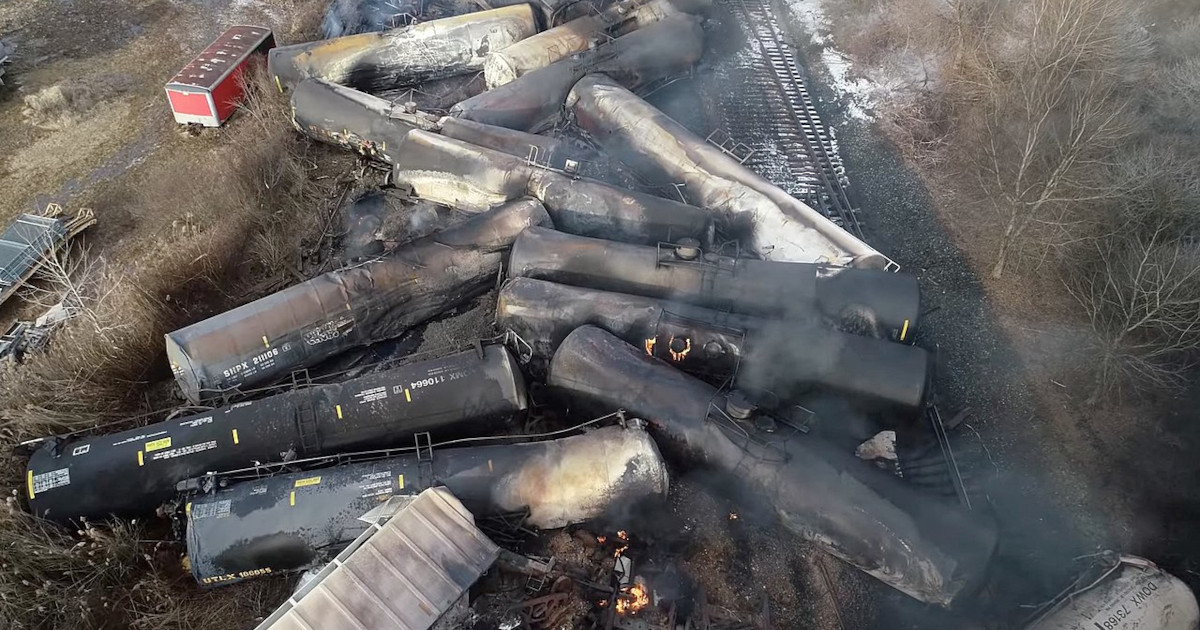East Palestine, Ohio: Prolonged Presence Of Toxic Chemicals After Train Derailment

Table of Contents
1. The Initial Impact of the East Palestine Train Derailment:
Types of Toxic Chemicals Released:
The Norfolk Southern train derailment released a cocktail of hazardous substances, including vinyl chloride, butyl acrylate, and ethylene glycol monobutyl ether. These chemicals present significant risks to human health and the environment.
- Vinyl chloride: A known carcinogen linked to liver cancer, brain cancer, and other serious health issues.
- Butyl acrylate: An irritant that can cause respiratory problems, skin irritation, and eye damage. Exposure can lead to lung damage and other respiratory complications.
- Ethylene glycol monobutyl ether: A toxic solvent that can affect the nervous system, kidneys, and reproductive system. Long-term exposure carries the potential for serious health problems.
While precise quantities released remain debated, the sheer volume of these chemicals released created an immediate and substantial threat.
Immediate Environmental Contamination:
The immediate aftermath saw widespread environmental contamination. The uncontrolled release of toxic chemicals led to significant pollution across multiple environmental media.
- Air Quality: Residents reported strong chemical odors and experienced respiratory issues immediately following the derailment. Air monitoring data revealed elevated levels of hazardous pollutants.
- Water Contamination: Nearby waterways, including Leslie Run and the Ohio River, showed evidence of contamination. Concerns remain about the long-term effects on aquatic life and the safety of drinking water sources.
- Soil Contamination: The derailment site and surrounding areas experienced significant soil contamination, posing a long-term environmental hazard.
2. Long-Term Effects of Toxic Chemical Presence in East Palestine:
Persistent Soil and Water Contamination:
Cleaning up the contaminated soil and water in East Palestine presents formidable challenges. The persistence of these chemicals in the environment means that the effects are far from over.
- Remediation Difficulties: Removing vinyl chloride and other persistent organic pollutants from soil and groundwater requires sophisticated and costly remediation technologies. The extent of contamination may require years of intensive work.
- Ongoing Monitoring: Continuous monitoring of water quality, soil samples, and air quality is crucial to assess the long-term effects and to guide remediation efforts. Independent studies are needed to ensure transparency and accuracy.
- Expert Opinions: Environmental scientists warn of the potential for lasting damage to the ecosystem, including damage to aquatic life and the potential for long-term soil infertility.
Health Concerns for Residents:
The long-term health effects on East Palestine residents remain a serious concern. Exposure to these toxic chemicals may lead to a range of serious health problems.
- Respiratory Issues: Increased rates of asthma, bronchitis, and other respiratory illnesses are expected following exposure to airborne toxins.
- Reproductive Issues: Some of the released chemicals are known to disrupt the endocrine system and impact reproductive health. Long-term studies are needed to fully assess these risks.
- Cancer Risks: The carcinogenic nature of vinyl chloride raises significant concerns about increased cancer rates in the affected population in the coming years. Comprehensive health monitoring programs are essential.
3. Government Response and Community Concerns:
Government Actions and Criticisms:
The government's response to the derailment has faced significant criticism. While cleanup efforts have begun, concerns linger about their adequacy and transparency.
- Cleanup Efforts: Norfolk Southern and government agencies have initiated cleanup operations, but the scope and efficacy remain subjects of ongoing debate.
- Health Assessments: Health assessments of residents are underway, but many feel they lack sufficient resources and comprehensive testing.
- Lack of Transparency: Many residents have expressed concern over the lack of transparency regarding the extent of the contamination and the long-term health risks.
Community Activism and Advocacy:
The East Palestine community has demonstrated remarkable resilience and advocacy in the face of this crisis.
- Protests and Demonstrations: Residents have organized protests and demonstrations, demanding greater transparency and accountability from government and Norfolk Southern.
- Lawsuits: Numerous lawsuits have been filed against Norfolk Southern, seeking compensation for damages and improved remediation efforts.
- Community Health Initiatives: Community-led initiatives are working to provide health support and resources to those affected. This includes independent monitoring and advocating for comprehensive health care services.
Conclusion:
The East Palestine toxic chemical presence continues to be a significant concern, underscoring the long-term environmental and public health consequences of this devastating derailment. The persistent contamination, ongoing health risks, and the ongoing struggle for transparency highlight the need for stronger regulations, improved emergency response protocols, and greater accountability from the responsible parties. To address the lingering East Palestine toxic chemical problem, we must commit to comprehensive monitoring of East Palestine's toxic chemical levels, support the affected communities, and advocate for policies that prioritize environmental protection and public safety. The long-term implications of this disaster demand sustained vigilance and a commitment to justice for those impacted. Ignoring the lingering effects of this disaster would be a profound disservice to the people of East Palestine and a dangerous precedent for future incidents.

Featured Posts
-
 Professional Selling And Retail Buying A Market Reaction Analysis
Apr 28, 2025
Professional Selling And Retail Buying A Market Reaction Analysis
Apr 28, 2025 -
 Federal Judge To Hear Case Of 2 Year Old Us Citizen Facing Deportation
Apr 28, 2025
Federal Judge To Hear Case Of 2 Year Old Us Citizen Facing Deportation
Apr 28, 2025 -
 Yankees Avoid Sweep Rodons Gem Leads To Victory
Apr 28, 2025
Yankees Avoid Sweep Rodons Gem Leads To Victory
Apr 28, 2025 -
 Financial Fallout Understanding The Changes At X Post Debt Sale
Apr 28, 2025
Financial Fallout Understanding The Changes At X Post Debt Sale
Apr 28, 2025 -
 Abu Dhabis 2024 Successes 1 1 Billion In Key Projects 26 2 Billion Real Estate Boom And More
Apr 28, 2025
Abu Dhabis 2024 Successes 1 1 Billion In Key Projects 26 2 Billion Real Estate Boom And More
Apr 28, 2025
Latest Posts
-
 Boston Celtics Player Skips Nba Award Push
May 12, 2025
Boston Celtics Player Skips Nba Award Push
May 12, 2025 -
 Boston Celtics Pritchard Lands Endorsement Deal With Converse
May 12, 2025
Boston Celtics Pritchard Lands Endorsement Deal With Converse
May 12, 2025 -
 Nba Award Boston Celtics Guard Declines Campaigning
May 12, 2025
Nba Award Boston Celtics Guard Declines Campaigning
May 12, 2025 -
 Virginia Giuffres Car Crash Four Days To Live Claim
May 12, 2025
Virginia Giuffres Car Crash Four Days To Live Claim
May 12, 2025 -
 Celtics Payton Pritchard Signs With Converse
May 12, 2025
Celtics Payton Pritchard Signs With Converse
May 12, 2025
